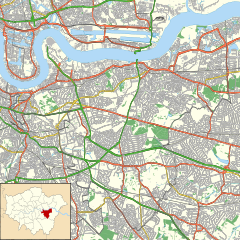Greenwich pumping station
| Greenwich pumping station | |
|---|---|
| General information | |
| Status | In use |
| Type | Pumping station |
| Architectural style | Italianate |
| Address | 101 Greenwich High Road |
| Town or city | London |
| Country | England |
| Coordinates | 51°28′38″N 0°01′06″W / 51.4772°N 0.0184°W |
| Construction started | 1865 |
| Design and construction | |
| Engineer | Joseph Bazalgette |
Listed Building – Grade II | |
| Designated | 16 December 1988 |
| Reference no. | 1213334 |
Greenwich Pumping Station, known until c. 1986 as Deptford Pumping Station,
History
After an outbreak of
Deptford pumping station was constructed to raise sewage from the southern interceptor sewers by 18 ft (5.5 m) into the
The original Deptford pumping station building, now a Grade II listed building, was built in London stock brick in an Italianate style,[3][4] and comprised two engine houses with a linking boiler house.[5] It initially housed four steam-powered beam engines (later replaced by diesel and electric pumps).[6] When installed, the engines at Deptford were the largest ever built.[7][8] Two adjacent coal sheds are also Grade II listed.[9][10][11]
Over 150 years later, in the early 2020s, the Greenwich pumping station site was the location of a shaft used to drive the Greenwich connection tunnel to Chambers Wharf on the
and intended to partly supersede Bazalgette's system.References
- ^ Greenwich Pumping Station, Open House London 2021. Accessed 2022-05-17
- ^ London County Council (1922). London Statistics 1920-21 vol. XXVII. London: London County Council. p. 99.
- ^ "Greenwich Pumping Station". London Open House. Retrieved 10 January 2020.[dead link]
- ^ "Deptford Pumping Station". PortCities. Archived from the original on 8 September 2019. Retrieved 10 January 2020.
- ^ Historic England (16 December 1988). "Pair of Beam Engine Houses with Linking Boiler House at Deptford Sewage Pumping Station (1213334)". National Heritage List for England. Retrieved 28 May 2020.
- ^ Phillips, Anthony (2 April 2019). "The man who built London's sewers". Weekender. Retrieved 10 January 2020.[dead link]
- ^ "How London got its Victorian sewers". Open Learn. Archived from the original on 6 June 2019. Retrieved 10 January 2020.
- ^ Collinson, Alwyn. "How Bazalgette built London's first super-sewer". Museum of London. Retrieved 10 January 2020.
- ^ Historic England (16 December 1988). "COAL SHED IMMEDIATELY TO SOUTH WEST OF PAIR OF BEAM ENGINE HOUSES WITH LINKING BOILER HOUSE AT DEPTFORD SEWAGE PUMPING STATION (Grade II) (1289021)". National Heritage List for England.
- ^ Historic England (16 December 1988). "SOUTHERNMOST OF PAIR OF COAL SHEDS TO SOUTH WEST OF PAIR OF BEAM ENGINE HOUSES WITH LINKING BOILER HOUSE AT DEPTFORD SEWAGE PUMPING STATION (Grade II) (1213549)". National Heritage List for England.
- ^ a b "Design and Access Statement: Greenwich Pumping Station" (PDF). Thames Tideway. Retrieved 28 March 2022.
- ^ "Greenwich pumping station". Tideway. Retrieved 10 January 2020.

